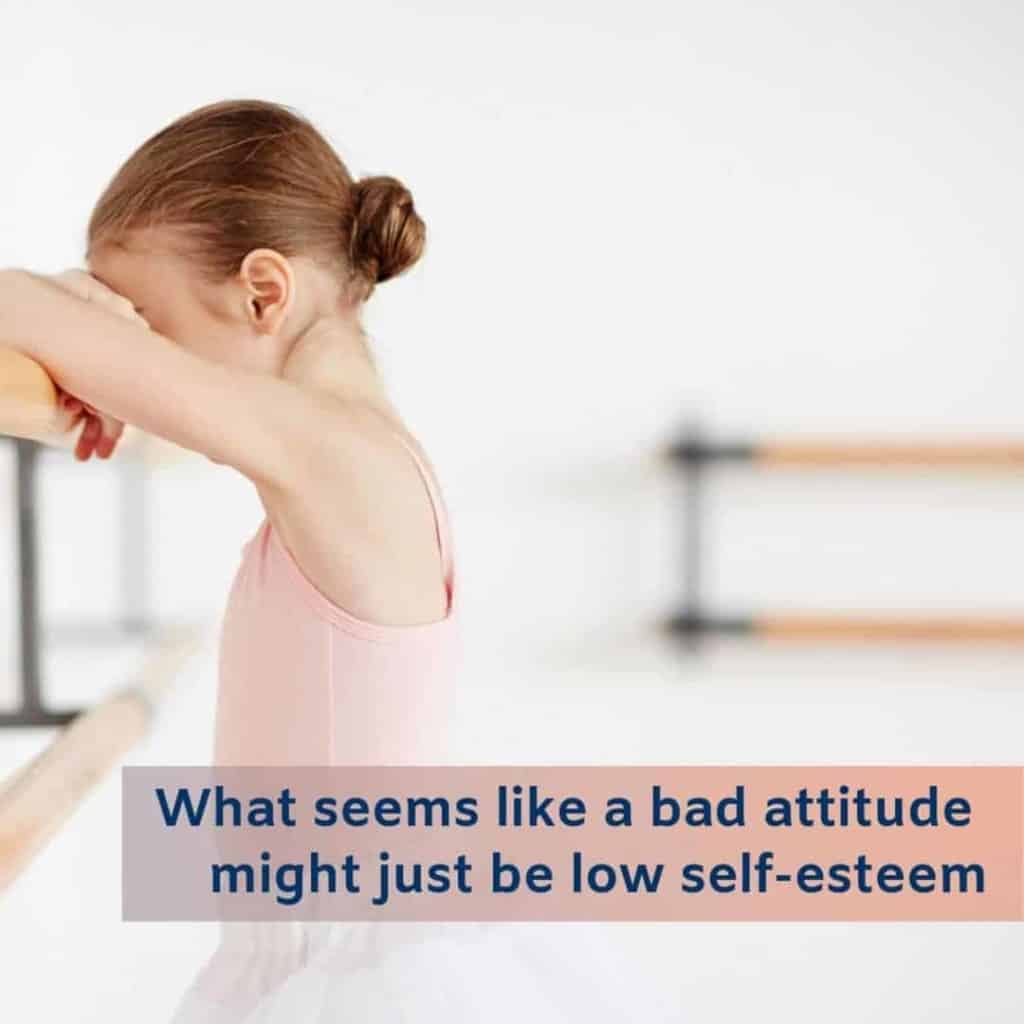Finding Refuge In Dance

by Rhee Gold
What seems like a bad attitude might just be low self-esteem.
“Susie, you eat too much!” exclaims a young dance student’s mom. “Susie, you’re a pain in the butt!” screeches her older brother. “Susie, can you just be quiet for one minute!” yells her dad.
This is the language and message Susie has heard, day in and day out, for her first 10 years of life. As a result she has a big problem with self-esteem. In school she’s quiet and doesn’t smile very much because she’s afraid she’s not good enough or that someone is going to yell at her. At dance school Susie is intimidated too, but there she seems to pout all the time. Her teacher has no idea what Susie’s home situation is like, so she reads the pouting as evidence of a bad attitude. In reality Susie loves to come to dance school and looks up to her teacher; she just doesn’t know how to express those feelings because she has no confidence—a direct result of her upbringing.
Susie’s dance teacher gets frustrated with her pouting and tells her that with that attitude she will never be a dancer. Susie used to get so excited to go to dance school to escape from the negativity at home, but now she has another adult in her life who is tearing her down. Each week her dance teacher makes a snide remark that duplicates the atmosphere she has at home. She becomes even more intimidated, thinking that her dance teacher doesn’t like her. Even worse, she tells herself, “I stink at dance, too!” Before long she drops out of dance. Why go to dancing school to be berated when you can get that at home?
Children like Susie can be frustrating, but as dance teachers we must accept the responsibility that we will have a major influence on each child in our classroom. Understanding that responsibility means that we have an obligation to help build self-esteem and to encourage all children to be the best they can be.
Maybe Susie’s dance teacher could look at her and say something like, “Susie, I know you have a beautiful smile—let me see that smile right now!” or “Come on up to the front of the class, Susie. I want you to help me today.” With that sort of interaction the teacher can change Susie’s behavior; she can create a safe haven for this child that will allow her to come out of her shell. Susie might become a confident adult because her dance teacher made the choice to encourage, rather than to discourage, her.
With more than 3 million children filling classrooms in dance schools each week, teachers should count building self-esteem as equal in priority to teaching the dance curriculum. The following are some suggestions to help all teachers create a caring dance experience for every child.
● Reward students. Offer praise or recognition when they accomplish a certain movement or when they seem to be giving their all in your classroom. Do all that you can to emphasize the positive things that they do, and don’t hound them with the negative.
● Take your students’ emotions and feelings seriously. Don’t belittle them with phrases like “We’ve been working on this so long; I don’t understand why you don’t have it yet” or “You’ll never be a good dancer because you don’t try hard enough.”
● Define policies clearly but allow breathing space for your students within those limits.
● Be a good role model. Let children know you feel good about yourself and that you have a passion for teaching them. Sometimes it is good to let them know you make mistakes and that you learn from them.
● Have reasonable expectations for your students. Realize that they need to learn the basics before they can accomplish the big stuff. Combining movement that they feel comfortable with and steps that are more challenging is a good way to balance your class. Always end the class with something that every student will feel good doing.
● Discuss issues or problems without putting blame on a student’s character. Those who feel like they’re being attacked will go deeper into their shells rather than trying to come up with a solution.
● Use positive comments like “Thank you, that was much better this time” or “You really impressed me this week.” Avoid criticisms like “Why can’t you keep up?” or “How many times have I told you?”
● If your students compete, do not put them under pressure to win. Encourage them to be the best they can be and be satisfied with that. Never confront them with demeaning language if they do not perform well or if they don’t win what you had hoped they would. Use encouraging language so that they don’t feel that they’ve let you down. There will be plenty of time to work on the flaws when you get back to the classroom.
The Susies of the world create an opportunity for dance teachers to learn how to deal with various kinds of personalities, because all of us will deal with children who seem withdrawn, belligerent, disinterested, or frightened during our teaching careers. Before you leap to passing judgment on them, remember that there is much that dance teachers don’t know about their students. By challenging yourself to come up with a friendly way to deal with these often misunderstood children, they can leave your classroom with their self-esteem intact or even boosted, even if they have to go home to a bad situation. By creating the right atmosphere and using a nurturing approach, you can make dance class a refuge for children who have little else that’s positive in their lives.








What a beautiful reminder of the power and importance dance teachers hold. Even in an hour a week, a life can be influenced — and changed. Thank you.
Thank you for sharing this, Rhee, your students are lucky to have you. I’d like to add that these principles apply equally well to adult students.